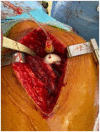Intraoperative assessment of femoral head perfusion during surgical hip dislocation for slipped capital femoral epiphysis
- PMID: 34377511
- PMCID: PMC8349592
- DOI: 10.1093/jhps/hnab018
Intraoperative assessment of femoral head perfusion during surgical hip dislocation for slipped capital femoral epiphysis
Abstract
Avascular necrosis is the most devastating complication of slipped capital femoral epiphysis, leading to collapse of the femoral head, increased risk of osteoarthritis and the requirement of early total hip arthroplasty. It is believed that intraoperative femoral head perfusion assessment may be an accurate predictor of post-operative avascular necrosis (radiographic collapse). At our institution, femoral head perfusion is assessed intraoperatively during all sub-capital realignment procedures. We hypothesize that our method is accurate in predicting the risk of developing post-operative avascular necrosis. In this retrospective study, we collected data from all patients that had intraoperative blood flow measurements during sub-capital realignment procedures. We correlated this with long-term radiographs looking for radiographic collapse. The intraoperative femoral head perfusion assessments during sub-capital realignment procedures for slipped capital femoral epiphysis at our institution, between January 2015 and March 2020 inclusive were assessed for reliability. In total, 26 of 35 patients had intraoperative femoral head perfusion present. Only 2 (8%) of these patients developed radiographic collapse. In contrast, 7 (78%) of the 9 patients who did not have femoral head perfusion present intraoperatively developed radiographic collapse, indicating that our method may be reliable in predicting a patient's post-operative risk of developing avascular necrosis.
© The Author(s) 2021. Published by Oxford University Press.
Figures




Similar articles
-
Bone Scintigraphy Prediction of Postoperative Femoral Head Avascular Necrosis in Children With Hip Trauma and Slipped Capital Femoral Epiphysis.J Pediatr Orthop. 2025 May-Jun 01;45(5):e418-e421. doi: 10.1097/BPO.0000000000002903. Epub 2025 Jan 16. J Pediatr Orthop. 2025. PMID: 40202262
-
Avascular necrosis post unstable slipped capital femoral epiphysis: a treatment algorithm with staged hinged hip distraction: mid-term results.Hip Int. 2019 Jul;29(4):438-445. doi: 10.1177/1120700018811313. Epub 2018 Nov 20. Hip Int. 2019. PMID: 30456991
-
Is Assessment of Femoral Head Perfusion During Modified Dunn for Unstable Slipped Capital Femoral Epiphysis an Accurate Indicator of Osteonecrosis?Clin Orthop Relat Res. 2016 Aug;474(8):1837-44. doi: 10.1007/s11999-016-4819-y. Epub 2016 Apr 18. Clin Orthop Relat Res. 2016. PMID: 27090261 Free PMC article.
-
[Complications of slipped capital femoral epiphysis].Srp Arh Celok Lek. 2007 Jan-Feb;135(1-2):105-10. Srp Arh Celok Lek. 2007. PMID: 17503578 Review. Serbian.
-
[Slipped capital femoral epiphysis: a modern treatment protocol].Srp Arh Celok Lek. 2009 Sep-Oct;137(9-10):562-6. doi: 10.2298/sarh0910562s. Srp Arh Celok Lek. 2009. PMID: 19950769 Review. Serbian.
Cited by
-
Persistent femoral neck non-union despite valgus intertrochanteric osteotomy: Relevance for secondary cam-type impingement.Trauma Case Rep. 2023 Aug 19;47:100911. doi: 10.1016/j.tcr.2023.100911. eCollection 2023 Oct. Trauma Case Rep. 2023. PMID: 37663374 Free PMC article.
-
Is there a role for controlled repositioning and mini-open primary osteoplasty in the management of unstable slipped capital femoral epiphysis?J Hip Preserv Surg. 2022 Jul 27;9(4):211-218. doi: 10.1093/jhps/hnac037. eCollection 2022 Dec. J Hip Preserv Surg. 2022. PMID: 36908554 Free PMC article.
References
-
- Loder RT, Richards B, Shapiro PS et al. Acute slipped capital femoral epiphysis: the importance of physeal stability. J Bone Joint Surg Am Vol 1993; 75: 1134–40. - PubMed
-
- Southwick WO. Osteotomy through the lesser trochanter for slipped capital femoral epiphysis. JBJS 1967; 49: 807–35. - PubMed
-
- Georgiadis AG, Zaltz I. Slipped capital femoral epiphysis: how to evaluate with a review and update of treatment. Pediatr Clin 2014; 61: 1119–35. - PubMed
LinkOut - more resources
Full Text Sources

